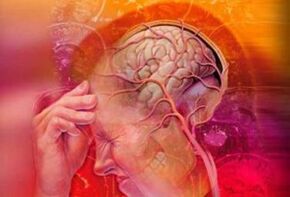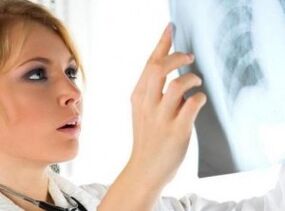Today's osteochondrosis is considered a "century disease", because most people are experienced by people whose work does not require increased motor activity.
In most cases, changes in the cartilage and bone tissue are observed in people of work - up to 40 years.
The disease can affect the different parts of the spine, and the second most common is the cervical area osteochondrosis.
What is it?
Osteochondrosis is an articular cartilage dystrophic disorder and adjacent bone tissue.
Previously, the term was extended to a large group of bone disease, but is now only used with degenerative spinal disease.

Compared to other spinal departments, the cervical region is the most mobile and has many nerve and vascular formations.The vertebral structure is small in size, as well as the fact that they are surrounded by relatively weak muscle corsets.
Such anatomical structures affect the development of osteochondrosis, the severity of clinical manifestations that depend on the nature of the change in the intervertebral disc and the degree of destruction.
The cause of the development of a disease
The main cause of cervical spinal osteochondrosis is an inactive lifestyle.
Due to a lack of physical energy with an inactive and sitting lifestyle:
- Metabolic processes are violated;
- salt levels in blood flow and lymph fluid increase;
- In the cervical region, in the kidneys and spinal liver, salt is placed.
Damage to the cervical vertebra is determined mainly by the lack of nutrients in the intervertebral disc.Therefore, the main causes of the occurrence of cervical osteochondrosis also include improper and unbalanced nutrition.
Risk factors
There are many risk factors for cervical osteochondrosis.

The most common factor is:
- descendants;
- Age -related changes;
- cervical spinal injury;
- hypothermia;
- Hormone disorders leading to metabolic disorders;
- Some autoimmune diseases that cause damage to cartilage (systemic lupus erythematosus, rheumatism).
What is dangerous
Not only the spinal cord and nerve root pass through the cervical spine, but also the vertebral artery, which is responsible for supplying the back of the brain, oval brain and cerebellum.
Therefore, with cervical osteochondrosis, the artery is squeezed, and as a result, a violation of cerebral circulation.
In more advanced cases, squeezing the arteries and adjacent blood vessels and nerve plexus can lead to consequences such as:
- Coordination violations;
- decreased hearing and vision;
- stroke.
If you do not cure the disease in the early stages, this can cause complications such as: the highlight of the intervertebral disc or the intervertebral disc hernia.
Stage of development of disease
Cervical osteochondrosis, such as other spinal osteochondrosis, develops gradually.There are 3 stages of the development of the disease.
1 degree
It is characterized by the onset of the destruction of the intervertebral disc.
Cracks in the fibrous ring, the strength and elasticity of the disc is formed, the height decreases, as the nerve roots are squeezed.
Character pain appears.Sometimes at level 1 (premature) such pain may be absent, and osteochondrosis continues with moderate discomfort in the neck.
2 degrees
If the 1st grade osteochondrosis is not treated or ineffective treatment, then the chronic condition occurs, which is the level of osteochondrosis.
The pain becomes constant, the destruction and seal of the intervertebral disc continues and leads to small dislocations of the cervical vertebra.
With cervical osteochondrosis, the fallen head syndrome can develop at this stage.The syndrome is characterized by severe pain, and one has to support his head in a regular condition to reduce pain.
3 degrees
The osteochondrosis of the 3rd degree cervical is accompanied by the following signs:
- headache;
- nausea;
- dizzy;
- cervix "bastard";
- Violation of upper leg sensitivity.
The fibrous rings are almost destroyed, leading to complications of osteochondrosis - an intervertebral disc or intervertebral hernia.
In 3 stages of osteochondrosis, the intensity of pain can be reduced, as the cartilaginus tissue affected in the intervertebral disc alone does not exist, which means no source of pain, but pinching the nerve root, so the pain does not completely leave.
Characteristics and symptoms of characteristics
There are many signs of manifestations of the disease.And they depend on the vertebrae damaged by the disease.

The characteristic syndrome for cervical osteochondrosis is:
- spinal syndrome;
- vertebral artery syndrome;
- cervical migraine syndrome;
- Hypertension syndrome.
All of these syndrome are accompanied, first of all, with various types of pain.
If we consider the vertebral artery syndrome, then the headache here shows itself in the early stages of the disease.
At the same time, pain attacks can be accompanied by:
- dizzy;
- shake gait;
- Visual symptoms (appearance of fog before the eyes, decreased visual acuity, etc.).fainting (with head movements).
With hypertension syndrome, increased intracranial pressure is determined.
Headaches are ruptured, can be accompanied by nausea and vomiting.With the severity of cervical osteochondrosis, the temperature increase and the increase in ESR can be observed.
When compressing the spinal root ("roying syndrome"), the following neurological symptoms may appear:
- called pain in the neck (cervicalgia);
- pain in the neck, spreading in the arms and shoulders (cervicobrachialgia);
- pain in hand;
- the sensation of crisis or cod in the neck when turning on the head;
- Pain "gives" to the ear, which occurs only after staying long in an uncomfortable position or sharp movement;
- pain or coma sensation in the throat, respiratory disorders;
- numbness and tongue;
- tongue swelling;
- the weaknesses spoken;
- violations of hearing and vision;
- noise in the ear;
- General deterioration in well -being.
With "cervical migraine" syndrome, sympathetic nodes are irritated, leading to impaired reactivity from vessels -brain and blood circulation disorders.

As a result, hypertension can develop, often accompanied by:
- ears with congestion;
- Tachycardia;
- sound in the head;
- Call in the ear.
When compressing blood supply to the spinal cord, spinal stroke may occur.
Disorders of blood circulation in the brain with osteochondrosis can cause:
- lack of oxygen of brain cells;
- mental disorders (depression, panic attacks);
- The appearance of signs -episindrome signs, such as short consciousness and entire body tension -are often confused with epilepsy signs.
Signs of cervical osteochondrosis as changes and heart rhythm, such as extrasystole or arrhythmia, are very common.
Such signs are very common among drivers and office workers.
Due to an inactive lifestyle in the cervical spine intervertebral dish and thoracic spine, changes occur, leading to disruption in the liver.
In most cases, until osteochondrosis is cured, it is almost impossible to eliminate disorders in the heart rhythm.
Swelling under the eyes can also indicate osteochondrosis of the cervical area.
Often, they depend on the position of the head during the night sleep, pass all day and combine with headaches, dizziness, head weight, etc.
Vegeta -vascular dystonia is another common disease that occurs in this disease.
This is the result of pinching the vascular artery that goes beyond the side of the spinal column.
Diagnostic method
Early diagnosis was established by a neurologist during an early examination of the patient.Recently, the doctor had to diagnose, only performed an external examination of the patient and sent it to X -Ray.
But, unfortunately, in X -Ray, it is impossible to see the complete picture of the development of the disease.

Currently, exams such as computed tomography and magnetic resonance imaging are available, where you can fully evaluate the level of development into disease.
After the diagnosis is made, the patient goes to a doctor who specializes in this field.
Which doctor is treated?
Narrow orientation specialists are involved in treatment - vertebrologists or vertebroneuris.
Treatment of cervical osteochondrosis
The basis for the treatment of cervical osteochondrosis is the severity of the main clinical symptoms.
In the cervical region, symptoms are mainly associated with squeezing blood vessels and nerve endings, therefore, during treatment, edema is especially relieved and blood circulation is restored.
There are many methods of treatment used in the treatment of cervical spinal osteochondrosis.
The most effective treatment is complex, which is a combination of several conservative treatment methods.
The complex treatment of cervical osteochondrosis may include the following traditional and non -traditional methods: drug treatment, massage, acupressure, manual therapy, physiotherapy, acupuncture, homeopathy, folk remedies, etc.
The level of treatment for osteochondrosis is the same for all localization of the disease:
- First you need to remove the pain syndrome.
- Then edema will be removed.
- At this stage, it is necessary to normalize blood circulation.
- Strengthen the muscle corset.
- Improve nutrition and tissue regeneration.
Only a good team of experts, including neurologists, physiotherapists, masseurs, surgeons, vertebroneurologists, can choose the most appropriate therapy.
Like the disease, treat the cervical area osteochondrosis in the early stages of the incident.If you do not start the process, then at this stage you can achieve complete healing of osteochondrosis.
Unfortunately, 2 and 3 stages of cervical osteochondrosis are accompanied by complete destruction or partial intervertebral disc, so this stage is characterized by a very long recovery process.
First aid
How to relieve pain with severity?
With severe pain, you should take anesthetics from the home medical cabinet.You can also attach pepper patches with pain.
When edema appears, diuretics can be taken.Rubbing the neck area with painkillers can help.
Medical Physical Education in severity is contraindicated, as well as heating, as this influence can cause serious complications.
After removing acute pain, you should consult your doctor immediately to consult.
Treatment with medications
Medicines most often start with injection (with severity), then switch to tablets and candles in combination with the use of local ointments and gels.
Anesthesia in the treatment of drugs is performed using anti -steroidal drugs.
Be sure to prescribe a drug that restores cerebral circulation.
With pathological muscle tension, muscle relaxants, such as midocalm, can be prescribed.For more effective treatment, vitamins in therapeutic doses and trace elements are taken.
In the case of intervertebral hernia, surgical intervention is rarely recommended and the attending physician can offer to perform surgery.
Massage and self
This method goes well with physiotherapy and physiotherapy.You can take massage courses where -medical institutions, and switch to private practices.
Massage is required for cervical osteochondrosis to strengthen the muscles and relieve tension in the neck.
The job of a massage therapist is to eliminate harmful metabolic products, as well as relieve cramps from the pathological zone by increasing the outflow and blood flow in the pain zone.
The main techniques used by experts during neck massage are:
- See;
- squeeze;
- trituration;
- vibration;
- knead.
Self -techniques can be carried out using the following techniques:
- Encourage (movement should be soft, without much effort to form folds);
- knead (a deep effect on the muscles, by catching in folds, pressure and subtraction);
- Vibration (the effect of oscillation with shade, shaking, patting).
Self must always be prepared by wiping.During vibration, you can use the massager.
The highest massage
Excess massage relieves headaches with severity of cervical osteochondrosis, helps with pressure surge, normalizing it.
Acupressure Scheme:
- The effect on the feng feng point, located below the Occipital hill, for 1 minute.
- The effect on the feng-chi point, located at the width of the two fingers of the special process of the skull.
- Exposure for 1-1.5 minutes at the I-Men point (located at a distance of three fingers wide from the phen-fu point).
- Sedative exposure is 1-1.5 minutes at the dowel point (7th cervical vertebra).
After acupressure, it is necessary to lie down for a few minutes, as small dizziness may occur.
Manual therapy
Manual therapy helps to overcome both acute and chronic pain, also increases the amount of movement and improves posture.
The main technique of manual therapy for cervical spinal osteochondrosis:
- Relaxed massage and segment.It is used to warm the muscles and relieve tension.
- Mobilization.Effects aimed at restoring joint function.The method of attractiveness.
- Manipulation.A sharp impulse aimed at the patient's pathological zone.This procedure is accompanied by a feature crisis (return joint to normal position).
Manual therapies that practice experts should have these techniques perfectly.Otherwise, any error can cause injury.
Acupuncture
Acupuncture contributes to the release of cortisol into the blood.This hormone has an anti -inflammatory effect.

Acupuncture is made by exposure to the point near the inner edge of the scapula.The needle is introduced to a depth of 1 - 2 cm and is left exposed to 10 - 30 minutes.
Homeopathy
Drug treatment has many side effects, so homeopathy can be a suitable substitute for unwanted treatment.
With cervical osteochondrosis with spoken hypertension (expressed by back pain), strontium carbonate is used.
Give 3, 6, 12 and 30 breeding.
Characteristics of nutrition
Food should be saturated with calcium and magnesium.
These trace elements are located in fish and seafood, nuts, nuts and dairy products.
Usually neck osteochondrosis can be accompanied by atherosclerosis.In this case, a hard diet is recommended.
The diet is set for 3-4 months.It is necessary to limit the use of all products containing cholesterol.These include animal fat, type of meat fat, fatty dairy products, and more.Also, the use of salt, sugar, flour products should be limited or excluded.
It is recommended to abandon bad habits (smoking, alcohol, etc. -more).
Cervical and alcohol osteochondrosis is intertwined.The fact is that when it falls into the blood, alcohol destroys the cells, thus aggravating the blood circulation that is already interrupted for osteochondrosis.
Therefore, it should be limited to the minimum, and during the severity period to fully abandon alcohol use.
Prevention
To prevent cervical osteochondrosis, it is recommended to comply with the following rules:
- The dream should be on a solid mattress and on a low pillow: the neck flexion angle should not be more than 15 degrees;
- Take a hot water bath daily for at least 10 minutes;
- Visit the sauna and bath as often as possible: warmly helps eliminate neck cramps;
- Let's our own aerobic load and running -regular walks at a low rate;
- Involved in swimming;
- After 25 years, avoid the surprise load on the spine (jump, walk);
- When sitting at work, make sure you take five hours per hour;
- Normal yoga classes can prevent any manifestations of cervical osteochondrosis;
- Refuse to visit the gym, as bodybuilding classes can trigger the cervical disc;
- Exercise as a prevention for neck osteochondrosis helps strengthen the cervical muscles, relieving tension.
Questions that are often asked
What to do during pregnancy, and how to treat it?
Often, during pregnancy that the first symptom of cervical osteochondrosis occurs.
This is due to changes in the hormone background and softening the vertebra, as well as due to the center of gravity and excessive burden on the spine.
The treatment of pregnant women's osteochondrosis is quite complicated, as it is limited to the drug method aimed at stopping pain.
You can use natural ointments or use folk medicine.
Any effects on the neck area (heating, charging, etc.) are strictly prohibited during pregnancy.
Do children and teenagers happen?
In children and adolescents, cervical osteochondrosis develops due to congenital cartilage deficiency or acquired.
It is expressed by headache complaints, rapid fatigue, dizziness and fainting.
Is it possible to warm the neck area?
Neck warning with cervical osteochondrosis is strictly prohibited, especially in the severity of the disease, as heating can lead to increased edema and the development of brain vessels.
How to sleep properly?
You need to sleep on a flat and hard bed with orthopedic mattresses.
The recommended and easiest position is on the side when the shoulder is located on the mattress, and the head is located on a small pillow.

The use of orthopedic pillows helps loosen the muscles in the cervix region, reducing nerve ending irritation, which prevents headaches and insomnia.
Are physical activity and bathing allowed?
In the steps of preventive and at 1 stage of cervical osteochondrosis, it is recommended to participate in physiotherapy and swimming training.
It is strictly forbidden to lift heavy, hard work, class in the gym.
Visiting baths and sauna are also recommended only for the prevention of cervical osteochondrosis and in the early stages of the disease.
























